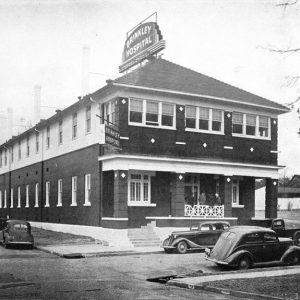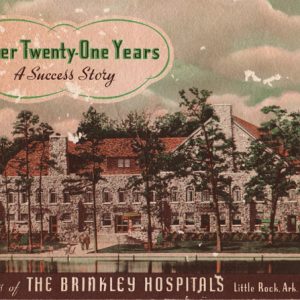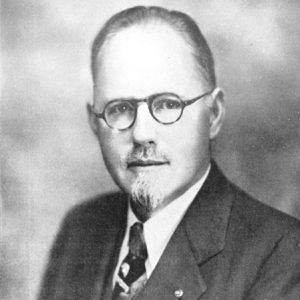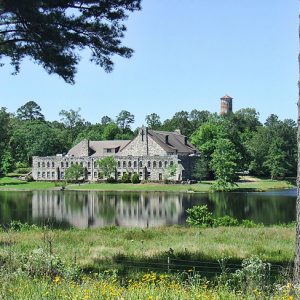calsfoundation@cals.org
John Richard Brinkley (1885–1942)
John Richard Brinkley made a fortune in medical quackery, radio, and advertising in Del Rio, Texas. In the late 1930s, he moved his practice to Little Rock (Pulaski County), where his dishonest career came to light and collapsed.
Born John Romulus Brinkley on July 8, 1885, in Jackson County, North Carolina, he was the illegitimate child of John Richard Brinkley and Sarah Candace Burnett, the twenty-four-year-old niece of his long-suffering wife, Sarah Mingus. There is some dispute as to why his middle name was changed from Romulus to Richard. The official biography by Clement Wood attributes the change to the Methodist minister who baptized Brinkley and rejected the name Romulus as heathen. Brinkley’s own account is that he took the name of his uncle, in fact his father, John Richard Brinkley, because he had been teased unmercifully by schoolmates over the name Romulus. Undoubtedly, some of the teasing was due to the family’s poverty and common knowledge that Brinkley was a love child. The elder Brinkley’s bivocational labors as a mountain doctor and itinerant preacher did not provide well for the family, but they did plant the seed of the younger Brinkley’s career in medicine and fundamentalist religion.
After the death of Sarah Burnett when the younger Brinkley was five, he was raised by his natural father and his wife, Sarah Mingus. When Mingus died in 1906, Sally Wike, a former schoolmate of the young Brinkley, attended the funeral and renewed acquaintance with him, beginning with an apology for the harsh treatment she and others had given him in earlier years. After a quick courtship, they were married on January 27, 1907. They eventually had three daughters and one son; the latter did not survive. After their divorce in April 1913, there was little contact between Brinkley and his former wife and three daughters. Within the year, on a trip through Memphis, Tennessee, Brinkley met Minerva (Minnie) Telitha Jones and married her even though a decree of divorce from Sally Wike had not yet been issued. After Brinkley obtained a divorce from Wike on February 21, 1916, Brinkley and Jones were once again married in Liberty, Missouri.
Meanwhile, after three years at Bennett Medical College, a school for eclectics in Chicago, and another year at Eclectic Medical University in Kansas City, Kansas, a notorious diploma mill, Brinkley had taken and passed the Kansas Eclectic Medical Board examination in 1915. The diverse theories regarding the best cure for illnesses in the late nineteenth and early twentieth century require this brief and oversimplified comparison. Homeopaths sought to cure diseases with small quantities of drugs that produced symptoms similar to those of the disease. Allopaths used drugs that produced results opposite those of the disease. Osteopaths and chiropractors, believing that illness originated in the bones, manipulated the spine to relieve symptoms of illness. Eclectics, as implied by the name, borrowed extensively from the other schools and taught basically the same science courses but advocated the use of herbal remedies in curing illness.
After moving to Milford, Kansas, Brinkley claimed in 1917 to be able to restore sexual vitality by transplanting goat gonads into a patient’s scrotum. He marketed his products on his own coast-to-coast radio station, KFKB, with a blend of fundamentalist religion, bedtime stories for children, and invitations to listeners to write him about their medical problems. After he had piqued the listeners’ interest, he plied them with carefully designed mailings, and soon they were paying inflated prices for basic medications or trekking to Kansas to pay $750 or more for the goat-gland operation. While in Milford, the Brinkleys had their only child, a son, on September 3, 1927; they affectionately called him Johnny Boy.
In 1930, the Federal Radio Commission (later the Federal Communications Commission) revoked Brinkley’s radio license, and Kansas authorities revoked his medical license. In 1932, he moved to Del Rio, Texas, and set up an even more powerful radio station, XERA, across the border in Villa Acuna, Mexico, to avoid regulation. He continued to market injections, using a glandular preparation to replace transplantation. He replaced goat gland surgery with a prostate operation for $250 and up. During the almost five years he was in Del Rio, he grossed $12 million by some estimates.
Brinkley moved his business to Little Rock in 1938 after another doctor appeared in Del Rio offering the same operation at a reduced rate. Brinkley’s staff performed operations at the old St. Luke’s Hospital at 1924 Schiller Street and offered rehabilitation care at another hospital on Arch Street Pike in a building that later became a Carmelite monastery. Brinkley’s career began to unravel in 1939 when he lost a suit against Dr. Morris Fishbein, editor of the Journal of the American Medical Association, for an article exposing the Brinkley operation as no more than a vasectomy and his famous Formula 1020 for restoring male virility as little more than colored water. Brinkley lost an appeal in which the judge, Robert J. McMillan, stated that the doctor “should be considered a charlatan and a quack in the ordinary, well-understood meaning of these words.” A number of civil suits and judgments against Brinkley followed, and he declared bankruptcy on January 31, 1941. In September 1941, a federal grand jury indicted Brinkley, his wife, and six former employees on charges of using the United States Postal Service for fraud. Only one of those indicted, Dr. J. H. Davis of Waldo (Columbia County), was an Arkansan.
Brinkley died of complications from a blood clot on May 26, 1942, before he could be brought to trial. He was buried in the Jones family plot at Forest Hills cemetery in Memphis. In slightly less than fifty-seven years, Brinkley had achieved wealth, power, and fame. However, the respectability he had wanted more than anything since his childhood days eluded him to the end. Whether he truly believed in the efficacy of his proposed cures is difficult to say, but the overwhelming rejection of those remedies by the American Medical Association (AMA) and the courts of the land should have made that belief untenable.
For their parts in Brinkley’s multi-million dollar schemes, his wife and employees were sentenced in January 1943. Minnie Brinkley pleaded nolo contendere and received a $5,000 fine and three years probation. Dr. Horatius Dwight Osburn pleaded guilty and received the same sentence. Drs. J. H. Davis, Orville B. Chandler, Lewis Kline, and a nurse, Vera Wederbrook, all pleaded guilty and received suspended sentences and three years probation. Dr. A. C. Petermeyer pleaded guilty and received a sentence of one year and a day. These sentences marked the end of the John R. Brinkley era in Arkansas. However, the story of Brinkley has continued to attract attention long after his death. He was the subject of two books published in 2002, and in 2016, the cartoon documentary Nuts!, covering his career, debuted at the Sundance Film Festival.
For additional information:
Brock, Pope. Charlatan: America’s Most Dangerous Huckster, the Man Who Pursued Him, and the Age of Flimflam. New York: Crown, 2008.
Carson, Gerard. The Roguish World of Doctor Brinkley. New York: Holt, Rinehart, & Winston, 1960.
Childs, William Gordon. “Goat Testicles, Scientific Evidence, and Consequences: Stopping a Killing Spree with Nothing but Evidence Law.” University of Arkansas at Little Rock Law Review 42 (Fall 2019): 147–170.
Dougan, Michael B. “The Blue Flame; or, Quid Sit Jus, et in Quo Consistit Injuria, Legis est Definire: Medical Malpractice in Arkansas in the Twentieth Century.” In Contributions to Arkansas Medical History: History of Medicine Associates Research Awards Papers, 1988–1992, edited by Edwina Walls Mann. Kansas City, MO: Walsworth Printing Co., 1999.
John R. Brinkley Papers. Kansas State Historical Society, Topeka, Kansas.
Juhnke, Eric S. Quacks and Crusaders: The Fabulous Careers of John Brinkley, Norman Baker, and Harry Hoxsey. Lawrence: University Press of Kansas, 2002.
Lee, R. Alton. The Bizarre Careers of John R. Brinkley. Lexington: University Press of Kentucky, 2002.
Schneider, Albert J. “‘That Troublesome Old Cocklebur’: John R. Brinkley and the Medical Profession of Arkansas, 1937–1942.” Arkansas Historical Quarterly 35 (Spring 1976): 27–46.
Williams, Nancy A., ed. Arkansas Biography: A Collection of Notable Lives. Fayetteville: University of Arkansas Press, 2000.
Albert J. Schneider
Arkansas Service Commission
 Brinkley Hospital
Brinkley Hospital  Brinkley Hospital Brochure
Brinkley Hospital Brochure  John Brinkley
John Brinkley  Marylake Monastery
Marylake Monastery 



I was born in Brinkley, AR, which I heard was named after the notorious John Brinkley. [Editors note: The town is actually named after railroad man Robert Campbell Brinkley.] When I was a young man, my grandmother, Marie Thompson, regaled me with a number of stories of the region. She told me that Dr. Brinkley was considered something of a heroic genius and even had a statue erected to him in the park. However, he was shamed for his theory and belief that human parts could be replaced by those of a goat. The townspeople of Brinkley tore down his statue in the park. These many years, Ive imagined that Dr. Brinkley must have been something of a visionary and was mostly defamed by some narrow-minded religious opposition to using animal parts to cure humans. Now I finally know the truth of the matter.